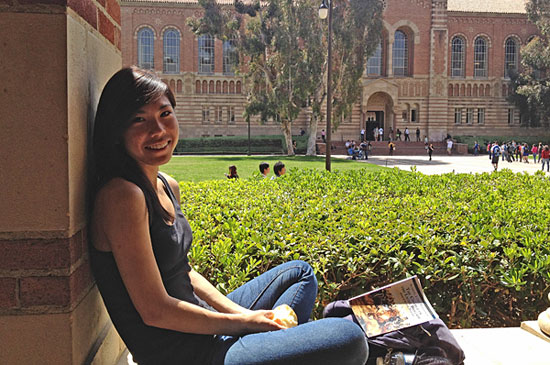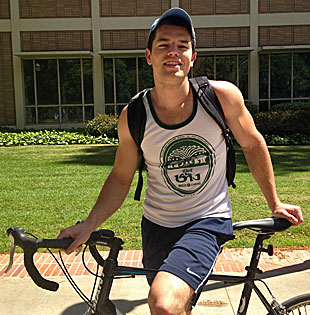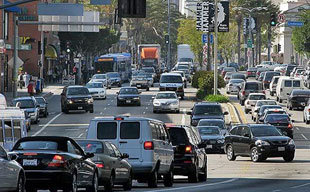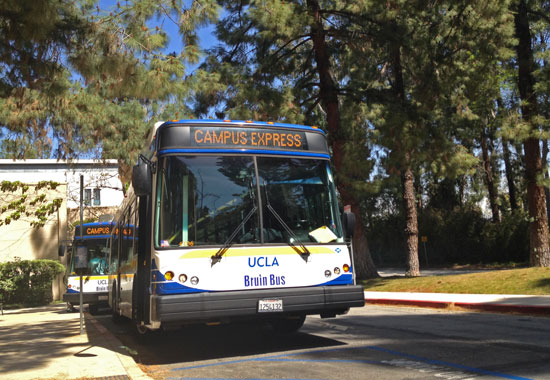How UCLA aced its traffic test
April 11, 2012
They said it couldn’t be done. Some said it shouldn’t be done. Yet to the surprise of many, it got done—a vast expansion of UCLA’s facilities without an equally vast increase in cars moving into and out of the campus.
In fact, more than two decades after the university embarked on a long range plan to add millions of square feet to its Westwood campus, the number of trips in and out of UCLA each day stands at its lowest point since such record-keeping began in 1990.
What’s more, it appears that the university’s culture of transportation has changed, too, with just under 53% of its employees driving alone these days—compared to nearly 72% in the county as a whole, according to the university’s latest “State of the Commute” report. The number of those taking public transportation to and from campus has doubled in the past decade—due in large part to a generous bus pass subsidy program that’s funded by parking and citation revenue. The university’s vanpool program is large and visible. And BruinBus, the free, cross-campus shuttle, clocked more than 1.2 million trips last year.
“I love the BruinBus,” said Scott Morrison, a senior majoring in history who lives near campus in a fraternity. “Most people I know don’t have cars.”
Certainly, cars are still a major fact of life in Westwood—with congestion levels there among the worst in the city.
That makes it all the more improbable that an institution in the eye of L.A.’s traffic storm would be able to transform itself into a laboratory for alternative transportation solutions. And those efforts, oddly enough, were inextricably linked to the university’s ambitious, and controversial, growth plans.
Between 1990 and 2011, university officials estimate that campus square footage increased by 66%—from 10.4 million square feet to 17.3 million. Although the new buildings included the Ronald Reagan UCLA Medical Center, the Anderson Graduate School of Management and the Terasaki Life Sciences Building, much of the new construction has been for student housing. So even though UCLA’s student population went from 36,427 in 1990 to 40,675 last year—an increase of less than 12%—the percentage of students living on campus rose far more dramatically, from 12% to 29%.
The university’s evolution from commuter campus into a more residential environment means that more than 29% of students now walk to school. Among them is Erika Gonzalez, a first-year biology student, who said that getting from her dorm to class is a cinch.
“I just go down a little hill and I’m there,” she said. “I just walk everywhere.”
And not having a car—it’s prohibited for dorm residents unless a student has an off-campus job or paid internship—has become business as usual.
“Cars kind of become communal things,” said Holli Herdeg, a first-year Greek and Latin student who said dorm-dwellers turn to friends who live in apartments when they need a lift off campus.
A key turning point in the university’s transportation evolution came in 1990, when then-Chancellor Charles Young agreed to something that was relatively novel at the time: city-imposed caps on the number of trips into and out of campus that, if exceeded, would bring new development to a halt.
“Chuck said, yeah, I can live with that. All of his people, their mouths dropped open,” recalled Supervisor Zev Yaroslavsky, who at the time was a Los Angeles City Councilman representing the area.
“For us down in the trenches, it was a little bit of a gulp,” said Renée Fortier, the executive director of UCLA Events & Transportation, who at the time was the university’s associate director of transportation services. “We agreed with the city that we would measure every single trip into and out of the campus. If we went over, all construction would stop. It wasn’t an agreement that didn’t have teeth.”
A wide-ranging building program on campus was essential, Young said at the time, to keep and expand the university’s standing as a top-tier research university.
But community groups had serious concerns.
“This idea of not producing traffic is a bad joke,” Laura Lake, then president of Friends of Westwood, said skeptically at the time.
Today, Lake sees some positive signs, including the university’s vanpool program and its efforts to house more students on campus. But she questions whether the methodology provides an altogether accurate accounting of UCLA’s overall impact on traffic because it doesn’t include off-campus university-owned buildings in Westwood. “Unless one looks at the whole enchilada, you don’t know what you have,” said Lake, currently co-president of the group Save Westwood Village.
(The university said that the vast majority of employees who work in its Wilshire Center or in leased space elsewhere in Westwood park in UCLA-owned parking facilities and are counted as part of its daily trip averages.)
Sandy Brown, president of the Holmby-Westwood Property Owners Association, added that whatever the numbers show, the experience of driving through Westwood Village is still a “disaster,” especially during afternoon rush hour.
“There’s reality, and then there are studies,” she said. “I would tell you that the studies don’t match reality.”
For his part, Young believes the university succeeded beyond expectations on two difficult fronts by expanding the square footage on campus more than it had initially envisioned and reducing traffic “even more than we thought we would.”
“We knew it wasn’t going to be easy,” he said recently, “but there were actions that we could take that would guarantee or at least make it likely” that UCLA would stay within the agreed-upon limits.
The university, limited by the city of Los Angeles to 139,500 trips to and from the campus each day, got as high as 125,792 trips in 2003 before dropping to the record low of 102,027 last year.
Although the university is no longer required to report its trip counts to the city, it has continued to do so in annual “cordon count” surveys that measure traffic into and out of the campus. While city Department of Transportation officials said they could not immediately project how bad traffic would have been in the area without the agreement, they said it was safe to assume that any trip count that falls below what was mandated in the cap represents a reduction in cars traveling on Westwood streets.
Meanwhile, those still-crowded Westside streets are providing another incentive for UCLA students and staff to get on the alternative transportation bandwagon.
“The congestion is just so bad that some people are happy to let a bus operator drive,” said David Karwaski, UCLA’s senior associate director for Planning, Policy & Traffic Systems.
That’s certainly true of Christina Trieu, a third-year student who lives off campus but walks or takes the BruinBus to get around.
“I do have a car, but I don’t want to drive here,” she said. “It’s too crazy.”
Posted 4/4/12
















 405 bridge work causes a stink
405 bridge work causes a stink

